![]()
![]()
![]()
Use LEFT and RIGHT arrow keys to navigate between flashcards;
Use UP and DOWN arrow keys to flip the card;
H to show hint;
A reads text to speech;
91 Cards in this Set
- Front
- Back
|
What is the difference between non-indigenous, exotic, or non-native species and invasive species?
|
Invasive push natives out of habitat. Others are just from a different origin.
|
|
|
Generalist.
|
Able to utilize many food sources and a wide variety of habitats.
|
|
|
Specialits
|
One or very few food sources. Constrained to a single habitat.
|
|
|
R selector
|
Able to reproduce quickly. Lots of offspring.
|
|
|
K selector
|
Reproduce slowly. Very few offspring.
|
|
|
Are most invasive species K or R selectors?
|
R selectors.
|
|
|
What makes a species invasive? (5 factors)
|
No predators.
Similar climate/habitat to normal range. Unlimited food. Does not have to come from another continent/country. Generalist. |
|
|
Gypsy Moth
Lymantria dispar |
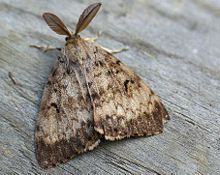
Released accidentally by Leopold Trouvelot in Medford MA. He attempted to produce silk with them. A few escaped and within some years defoliated most trees in the area. Very invasive.
|
|
|
European Starling
Sturnus vulgaris |

100 of these birds were brought to NYC because they were Shakespearian birds. Now population is 200mil. Eat seeds, grains, insects, ect... These birds invade nest cavities and pushed out many woodpeckers. Also carry diseases.
|
|
|
Nutria
Myocastor coypus |
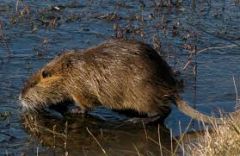
Originally in South America. Brought to Louisiana in the 1930s to harvest fur.
It feeds on wetland plants and burrows into damns causing flooding. Nutria were partially controlled by a bounty that was offered for killing them. |
|
|
Mongoose
Helogale javanicus |
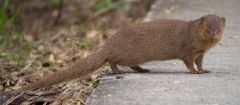
Introduced into Japan for snake control in the late 1800s. Effective.
Introduced in hawaii to control rats which were eating the cash crop sugar cane. Ate native birds instead. Rats are nocturnal. Birds and mongoose are not. |
|
|
Biological Control
|
Controlling one species with another.
|
|
|
Feral Pig
Sus scrofa |
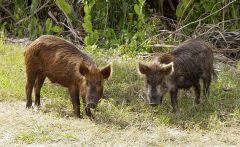
Pigs brought from Europe via ship. Eat literally anything. They were given to Native Americans by Hernando de Soto. Pigs are very destructive and push species out of vegetation. Also eats snakes in the woods.
|
|
|
Cane Toad
Rhinella marina |
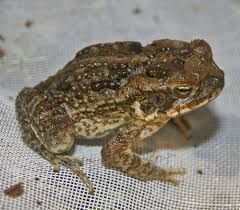
Intentionally introduced to eat sugar cane pests. Eat all insects, not just the pests. Prolific reproduction. In South and Central America and Australia. Adults have poison glands.
|
|
|
Honeybee
Apis mellifera |
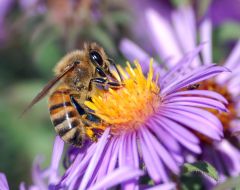
Native to Europe/Asia/Africa. Brought to US in the 1600s for honey. Probably caused many extinctions of native bee species. In Australia introduced in the 1800s and showed invasive behavior.
|
|
|
Brown Tree Snake
Boiga irregularis |
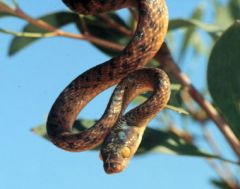
Got to Guam via cargo ships. Accidental. No predators there. Eats many birds, reptiles, amphibians, ect... Since 1940, killed off 12 bird species entirely. Vegetation diversity has gone down as well. Approximately 100 snakes to every 2.5 acres. Currently on the decline.
|
|
|
Hemlock Wooly Adelgid
Adelges tsugae |
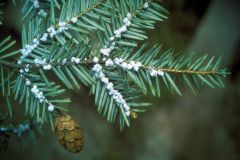
Little white egg cases. Very small aphid-like parasite. Killed almost all hemlocks. Native to Asia. Showed up in the 1920s.
|
|
|
Brown Marmorated Stink Bug
Halyomorpha halys |
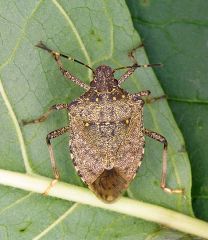
First noticed in PE in 1990s. Invasive because it pushes out other insects. Feeds on ornamental trees.
|
|
|
What types of organisms can be aquatic invasive species?
|
Invertebrates, vertebrates, plants, and diseases.
|
|
|
Vectors for aquatic species
|
Geologic events, flooding, storms.
|
|
|
Why has the rate and extent of aquatic invasive movement increased?
|
Human direct and indirect interaction.
|
|
|
Direct vectors - unintentional
|
Cargo ships taking up and releasing water.
Muddy boots from ponds going to different locations. Personal fishing boats going into different ponds. Fishing bait collected from one pond and released into another. |
|
|
Direct vectors - intentional
|
Some ponds are stocked with non-native fish for recreational fishing.
Invasive aquatic plants are sold from home depot. |
|
|
Indirect vectors
|
Canals introduce two different bodies of water to each other and can bring invasive species.
|
|
|
Indirect vectors - climate change
|
King crabs have been able to expand their habitat. Now seen invading Antarctic waters where they prey on local species.
|
|
|
What happens to most introduced species?
|
Most fail. Abiotic conditions are not conducive. Competitors reduce success. Predators eat them. They contract diseases.
|
|
|
What types of species become invasive?
|
Species with adaptive capacity. Those that are generalists, fast-growing, fast-reproducing, and migratory.
|
|
|
Lag phase
|
Period before explosive growth where the species is living in the new environment but keeping a stable population.
|
|
|
Log phase
|
Invasive species' population explodes, over-taking its competition.
|
|
|
Competition with natives
|
Invasive species invade and out-compete natives. An example is purple lossestrife which steals terrain and attracts pollinators.
|
|
|
Habitat alteration
|
Invasive species comes in and alters the habitat around it. Example is the swan which east submerged aquatic vegetation and alters the pond ecosystem.
|
|
|
Biodiversity decline
|
Invasive species are one of the leading causes of global biodiversity loss.
|
|
|
Costs in the US
|
The US suffers economic damages of aprox 137 billion per year from invasive species.
|
|
|
There are tangible economic benefits for reducing invasive species.
|
Fishing... Hunting... ?
|
|
|
Water Hyacinth
|
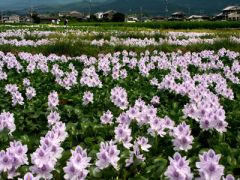
Considered the world's worst aquatic invader. Creates an almost impenetrable surface over ponds.
Invading NC. Used weevel to try eradicate it. Disappeared for a little while but it came back. |
|
|
Methods of managing invaders
|
Biological Control
Chemical Control Physical/Mechanical Control |
|
|
Zebra Mussel
|
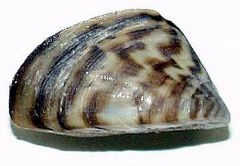
Native to Black and Caspian Seas. Found in Great Lakes in 1988. Because of series of channels, they have moves to most rivers in the North East US.
|
|
|
Zebra Mussel negatives
|
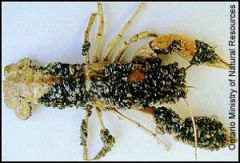
Zebra Mussel filters algae (but not toxic algae) and grows rapidly on everything. Causes toxic blooms because of algae feeding. Caused 500mil in damage per year in the great lakes alone. Buildup in pipes. Only possible control measure is to tell people to stop spreading it.
|
|
|
Asian Carp
|
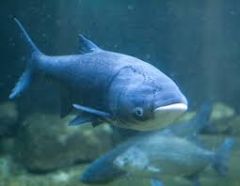
Invasive in Illinois River. Vectors: bait bucket transfer and live fish markets.
|
|
|
Why are some plants introduced intentionally?
|
Erosion control, ornamental plants, natural fences, or food for non-native animals.
|
|
|
How are some plans transferred un-intentionally?
|
Hitch-hiking seeds or fruits or contaminated agricultural crops.
|
|
|
Characteristics of invasive plant species
|
Quick growing and agressive.
Do NOT produce gigantic showy flowers or large fruits Abundant easily dispersed seeds that can withstand adverse conditions. Often are legumes (can fix nitrogen) for their own fertilizer. Release chemicals that limit surrounding growth or kill native plants (allelopathy) |
|
|
What climates are exotic plants especially threatening in?
|
Climates similar to their native habitats.
|
|
|
English Ivy
Hedera helix |

Brought for horticultural reasons and erosion control. Became invasive.
|
|
|
Japanese Honeysuckle
Lonicera japonica |
High photosynthesis rate in the winter. Highly invasive.
|
|
|
Why are legumes especially invasive?
|
They have symbiotic relationships with nitrogen fixing bacteria. They are also allelopathic.
|
|
|
Rhizobium Nitrogen Fixation
|
This is a bacterium that fixes N2. Plants provide homes for the bacteria and in return the Rhizobium removes O2 from nodules.
|
|
|
Kudzu
Pueraria spp. |

Introduced in 1876 in PA for ornamental reasons.
1907 Pleas discovered animals enjoyed it. Farmed it in FL and sold the root stock. 1930s-40s the government payed farmers $8 an acre to plant Kudzu for erosion control. 1998 classified as noxious weed by US. |
|
|
Kudzu damage
|
Interference competition. It outcompetes many other plant species and forces them out by stealing resources. Ex. light.
Also allelopathic and inhibits germination of many other plants. |
|
|
Chinese Wisteria
Wisteria sinensis |

Another invasive legume brought to the states because it was thought of as pretty.
|
|
|
Gorse
Ulex europaeus |
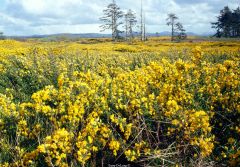
Prickly legume introduced as a natural fence.
|
|
|
Why were species brought to New Zealand?
|
Europeans wanted to hunt game in New Zealand. Brought wapiti, rams, boars, goats, small game and birds, deer, fish species, and chamois. There were no native mammal species in NZ.
|
|
|
What else was introduced in New Zealand in 1912 to support these Pheasant and Grouse populations?
|
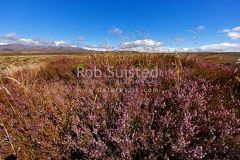
Heather! The game birds did not survive but the heather thrived.
Introduced a yorkshire beetle to combat the heather. |
|
|
Prickly Pear
Opuntia spp. |
Introduced in Australia as a fence and also as food for the cochineal scale insects (which produced red dye). Became very invasive.
Biological control was used to combat. |
|
|
Cactoblastis moth
|
Used as a predator for the prickly pear. Introduced to Australia in 1925.
|
|
|
Plantago major
Common Plantain |
Nick-named white man's footprint by Native Americans. Grows close to ground and can survive very cold conditions.
|
|
|
How are invasive plant species controlled?
|
Chemical control, physical control, or biological control.
|
|
|
What is used for chemical control?
|
Usually broad spectrum herbicides. These are not specific to any plants so they hurt native and invasive species. Chemicals are usually glyphosate or atrazine.
|
|
|
Why did the US department of agriculture start studying Kudzu's enemies in China?
|
Geographically similar. Wanted to see what could be used as a biological control.
Found 6 fungal pathogens. 25 insect species (7 of which feed on other crops like beans so they could not be used) |
|
|
Kudzu bugs
Megacopta cribraria |
Introduced in US in 2009. Feed on Kudzu. Also feed on all other bean crops so they are considered peses.
|
|
|
Biological control for Kudzu
|
GOATS!
|
|
|
Physical kudzu control
|
must cut under the knob to wipe the plant out.
|
|
|
Today the movement of species around the world has become _________ widespread and ____________ difficult to control.
|
More, more
|
|
|
Once introduced, alien species spread by...
|
Anglers, farmers, inter basin transfers.
|
|
|
T of F. Invasive species are more common than native species in the waters samples in article 6.
|
True
|
|
|
Why were most bass and trout introduced into the US waterways?
|
Sport
|
|
|
T or F. Introducing fish species for sport increases biodiversity.
|
False.
|
|
|
Study 7 was concerned with...
|
conservatiion of species/biogeography.
|
|
|
A representative measure of ________ through an ecosystem is considered net primary productivity (NPP).
|
energy flow
|
|
|
One was of assessing humanity's impact on ecosystems is to calculate HANPP. Through what conversion to we calculate HANPP?
|
Anthropogenic change of land to serve other means.
|
|
|
Human population density and species richness respond similarly to variation in ______, leading to spatial congruence between human settlements and productive species rich regions.
|
NPP.
|
|
|
Australia's largest national parks are mostly in areas of ________ productivity.
|
Low
|
|
|
What is the most common fate of non-native organisms?
|
They die en route to the new location or they are killed quickly upon arriving to the new environment.
|
|
|
Most invasive vertebrates, such as fish, mammals, and birds, have been introduced _______.
|
Deliberately.
|
|
|
What is the period of time where a population size remains relatively small and grows slowly?
|
Lag phase.
|
|
|
Which is not one of the means by which a newly established species may survive and persist long enough to become invasive, according to the article?
|
Exposure to environmental stress tends to result in increased recruitment.
|
|
|
What makes an environment vulnerable to invasion by non-native species?
|
Lots of vacant niches in the new environment.
Community disturbance at the time of invasion. Lack of competitors or predators. Low species richness in the new environment. Close proximity to a coast or port. |
|
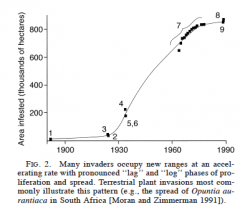
What conclusion can be drawn from figure 2?
|
In 1934, the density of stems/hectare of American chestnut were higher than in 1953.
|
|
|
Which is not paired with its invasive species?
|
Nile perch with the Lake Victoria cichlid fish.
|
|
|
Which is not correctly paired with the mechanism by which their populations are being reduced?
|
Carpobrotus edulis : Hybridization
|
|
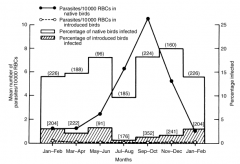
According to figure 3 which is true?
|
Native birds have a greater number of parasites in their blood on average all year round compared to introduced birds.
|
|
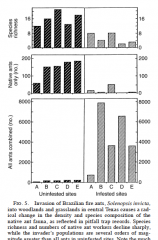
What conclusions are correctly drawn from figure 5?
|
Uninfested site C was the site with the largest numbers of species in the study.
Twice as many total ants were counted in Infested site B as Infested site C. |
|
|
According to the article, what is one of the general ways in which invasive grasses harm ecosystems which they invade:
|
encouraging fires.
|
|
|
Conversion of a forested area into grassland would likely result in all of the following except:
|
greater photosyntheses per unit area, leading to increases sequestration of carbon (and CO2) in the form of plant matter.
|
|
|
Governments have rarely spent a lot of funds on preventing invasive species spread primarily because:
|
the exact cost and economic impacts of invasive species are not clear.
|
|
|
Under quarantine controls, the US uses the "innocent until proven guilty" method. This means that...
|
Only harmful species are quarantines.
|
|
|
If a government attempted to eradicate a species, when would the ideal time of eradication occur?
|
Shortly after a species has been detected.
|
|
|
The "vietnam of entomology" is a metaphor used to refer to our war against imported fire ants. What does this mean?
|
It is a war that we are making extremely slow progress in (if any) and it is going to be a long war.
|
|
|
If eradication is not possible, most government agencies support maintenance control methods. This could include all of the following except:
|
Preventing entry of a species into National and State parks.
|
|
|
The use of the cactus moth to combat prickly pear cactus is an example of:
|
biological control.
|
|
|
An organism is introduced with the intention of eradicating a non-native pest species. Instead, the introduced organism eradicates a native species. In this example, the species which was eradicated was:
|
A non-target species.
|

